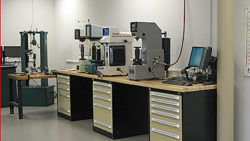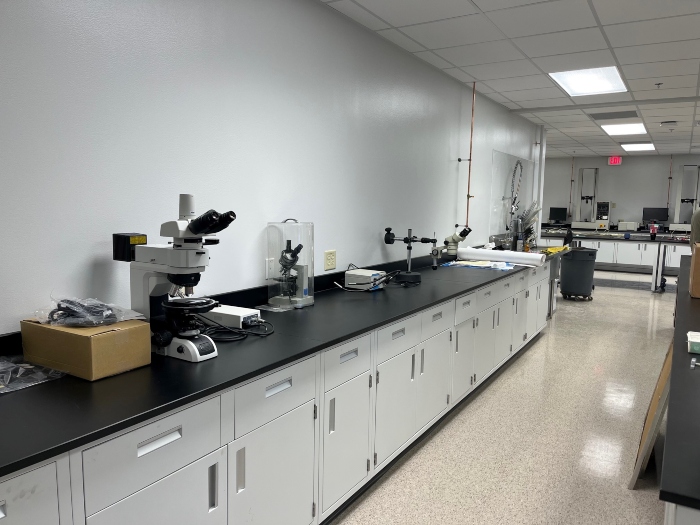Comprehensive Material Testing Lab: Your Partner for Exact Quality Control
Comprehensive Material Testing Lab: Your Partner for Exact Quality Control
Blog Article
Developments in Material Testing for Enhanced Quality Control
In today's hectic and competitive markets, making sure high-grade materials is critical to success. As modern technology proceeds to advance, so does the demand for much more sophisticated material screening methods. From non-destructive testing strategies to automated systems, the field of material testing has seen amazing innovations. In this conversation, we will check out several of the most recent fads in material screening, consisting of using innovative sensor modern technologies, the integration of information analytics, and the role of expert system. These growths not only guarantee boosted quality guarantee but likewise hold the possible to transform sectors across the board. So, allow's study the world of improvements in product testing and find just how these innovations are shaping the future of top quality assurance.
Non-Destructive Examining Approaches
Non-Destructive Testing Methods play a crucial duty in making sure the integrity and high quality of products without jeopardizing their architectural integrity. These methods are employed in different markets, including aerospace, manufacturing, and building, to identify and identify issues or anomalies in products or structures. By utilizing non-destructive testing professionals, engineers and techniques can examine the buildings, characteristics, and performance of materials without triggering any damages.
One commonly used non-destructive testing technique is ultrasonic screening (UT) UT includes the use of high-frequency sound waves to spot imperfections such as cracks, spaces, and inclusions in products.

Non-destructive screening approaches provide valuable information about the high quality and reliability of materials, making certain that they meet the needed standards and specifications. By applying these strategies, sectors can boost their top quality guarantee procedures, reduce the danger of failure or accidents, and ultimately supply more secure and more dependable products to customers.

Automated Screening Systems
Automated screening systems have actually changed the area of material testing, providing precise and reliable approaches for examining the high quality and integrity of materials. These systems make use of innovative innovations and algorithms to automate the screening procedure, minimizing human error and increasing productivity.
One trick benefit of automated testing systems is their ability to execute examinations at a much faster rate than manual screening techniques. With making use of robotics and sophisticated software program, these systems can perform several examinations simultaneously, substantially decreasing the time needed for testing large batches of products.
In addition, automated screening systems use a higher degree of accuracy and precision compared to manual screening. They can execute tests with consistent specifications, ensuring that the outcomes acquired are reproducible and reliable. By getting rid of human subjectivity and irregularity, these systems supply a more unbiased assessment of material top quality.
Additionally, these systems are outfitted with sophisticated sensing units and detectors that can discover also the smallest issues or discrepancies in product buildings. This makes it possible for early discovery of potential issues, permitting manufacturers to take restorative activities before the materials are made use of in crucial applications.
Along with their efficiency and accuracy, automated screening systems also boost safety in material screening. By minimizing human involvement in possibly unsafe testing procedures, these systems decrease the danger of injuries and accidents, making sure a safer working environment.
Advanced Sensor Technologies
With the combination of sophisticated sensing unit technologies, material testing systems have accomplished even higher levels of precision and effectiveness (material testing lab). Advanced sensing unit modern technologies play an essential role in improving the quality control process by supplying real-time and precise data during material testing. These sensors can discovering and gauging various physical residential or commercial properties such as temperature level, strain, vibration, and stress, enabling an extensive analysis of the product's actions under different conditions
One of the crucial developments in sensor technologies is the growth of wireless sensors. These sensing units get rid of the requirement for cumbersome circuitry and allow seamless information transfer, enhancing the general flexibility and mobility of the screening process. Cordless sensors can be conveniently integrated into existing product testing systems, making them a cost-efficient service for enhancing and updating testing capacities.

Expert System in Product Screening
Expert system click for more has actually transformed the area of product testing, bringing unmatched degrees of precision, efficiency, and predictive capacities to the quality assurance process. With the capacity to analyze large quantities of information and recognize patterns that may go unnoticed by human operators, AI formulas have actually greatly improved the dependability of product screening procedures.
One of the essential benefits of making use of AI in product screening is its ability to predict material habits under different problems. By educating AI versions on historic information, scientists can create anticipating versions that can approximate the efficiency of products in real-world circumstances. This allows manufacturers to enhance material choice and style, minimizing the click here now requirement for expensive and lengthy experimental procedures.
In addition, AI can automate and simplify the product screening procedure, enhancing effectiveness and reducing human mistake (material testing lab). AI-powered systems can autonomously lug out screening procedures, gather and evaluate data, and generate comprehensive reports. This not just conserves time but also ensures dependable and consistent outcomes
In addition, AI can find and examine material defects or abnormalities with high precision. By comparing examination results to predefined requirements, AI algorithms can promptly determine discrepancies and alert drivers to prospective issues. This very early detection of issues assists avoid faulty products from entering the manufacturing procedure, ultimately boosting item quality and consumer fulfillment.
Integration of Information Analytics
Data analytics plays a crucial function in the combination of material screening processes, making it possible for producers to make and remove useful understandings notified choices. By using advanced analytic methods, manufacturers can assess large quantities of data gathered throughout material testing to recognize patterns, trends, and abnormalities that might impact the high quality and efficiency of their products.
Combination of information analytics in product screening permits producers to keep an eye on and examine different criteria and variables during the screening procedure. This includes elements such as temperature level, stress, strain, and other environmental problems that can influence the actions and characteristics of materials. By assessing this information, manufacturers can acquire a deeper understanding of exactly how various variables interact and influence the performance of their materials.
Moreover, information analytics aids in recognizing possible defects or weaknesses in materials, enabling manufacturers to take proactive steps to deal with these problems prior to they cause item failings or security dangers. This aggressive strategy can significantly improve the total quality control procedure and boost consumer satisfaction.
In addition to recognizing issues, information analytics can additionally maximize material testing procedures by determining areas of improvement and suggesting modifications in the testing protocols. By analyzing historic information, makers can recognize patterns and fads that can aid them simplify their screening procedures, minimize prices, and improve efficiency.
Conclusion
In final thought, innovations in material screening have actually caused boosted high quality assurance in various sectors. Non-destructive testing techniques, automated screening systems, advanced sensor technologies, and the integration of data analytics have all played a substantial role in boosting the accuracy and effectiveness of material screening procedures. Furthermore, the application of expert system in product testing has actually further contributed to the advancement of more exact and dependable screening techniques. These innovations have led to better items and enhanced client fulfillment.
From non-destructive testing methods to automated systems, the area of material screening has actually seen amazing innovations. Wireless sensing units can be conveniently integrated right into existing product screening systems, making them an economical service for enhancing and updating screening capacities.
Combination of information analytics in product testing enables makers to monitor and assess different criteria and variables throughout the testing process. Non-destructive screening useful link approaches, automated screening systems, advanced sensor innovations, and the assimilation of data analytics have all played a considerable function in boosting the accuracy and effectiveness of product testing procedures. In addition, the application of man-made knowledge in product screening has additionally added to the growth of even more trustworthy and precise screening strategies.
Report this page